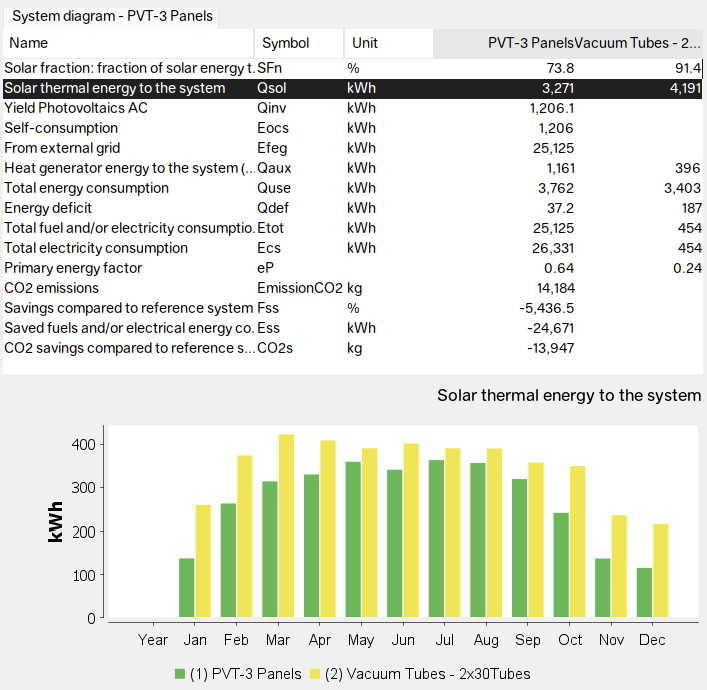Rules of Thumb for sizing a Domestic Hot Water Heater
Introduction
Before sizing a domestic hot water heater, regardless of energy source (whether electric, gas, solar, oil, etc...) you need to know your annual and monthly domestic hot water (DHW) demand in KWh or BTU.
DHW demand depends on many tangible and intangible factors. Tangible factors (such as Domestic Cold Water inlet temperature, flow, DHW outlet temperature, appliances and sanitary fixtures demand, etc....) can be easily predicted using historical data. The difficulty in DWH annual or/and monthly demand derives from the intangible factors such as human habits and home owners demographics.
Appliances usage frequencies such as dishwasher, washer, dryer, coffee machine, cooking habits are not easily predictable. Home owners demographics are a bit easier to predict: a family of four with babies don't have the same showering frequencies as a family of 4 with 2 adolescents and the list goes on.

Demographics
Demographics is a major factor in determining DHW heating consumption, which strongly influences the size of every components of your solar water heater.
Family Size, Age, lifestyle (such as living in a large city, small city or rural area, etc....), Number of Kids, Number of Pets, Availability of Green Spaces around the house, and many other factors affect the selection of every Solar Water Heater.
As an Example a family with two kids and two adults consumes DHW three times than a family with two retired seniors living alone.
Assumptions and Results
Taking into account all or most of the above mentioned tangible and intangible factor goes beyond the scope of this blog (because it simply leaves us with an infinite amount of scenarios). There are many available tools (such as simulation software or even Microsoft Excel) in the market that can do that.
For the purpose of this article, we have made the following assumptions which we believe are applicable for a big portion of the southern part of Canada:
- Monthly Domestic Cold Water Inlet Temperature (˚C): January-4.54˚C, February-5.25˚C, March-6.67˚C, April-8.8˚C, May-11.95˚C, Jun-13.32˚C, July-14.7˚C, August-15.38˚C, September-12.64˚C, October-9.9˚C, November-7.73˚C and December-5.6˚C.
- Domestic Hot water Supply Temperature = 60˚C.
- Average DHW Daily Consumption (GPD) = 12 GPD (Gallon per day).
- Home with one washing machine having a 6 GPD consumption and one dishwasher having a 7 GPD consumption.
Putting all the above into our simulation software and running the same simulation for a home of three, four and five persons give us the following results:
| Number of Person | Estimated Average Annual Domestic Hot Water Demand (KWh) |
|---|---|
| 3 | 4000 |
| 4 | 5000 |
| 5 | 6000 |
If you think the assumptions related to the above tabled results don't apply to your case, don't panic. DHW consumption is hidden in your utility rate energy bill.
In typical average Canadian Home, where annual energy consumption is 200KWh by Square Meter of home area, Annual DHW consumption is 20% of Total Home consumption in KWh (as shown in the above Pie Chart). If you have electricity and Gas Meter (or any other energy source such as propane, Oil etc..), the above 20% shall apply to the sum of all annual utilities bills.
20% of Annual Utility Bill is spent on DHW heating while 54% is spent on Space Heating and Space Cooling. Both represent 75% of Annual Utility Bill. By using a Hydronic system for both Heat and Cooling, we can cut down a sizable portion of annual utility bill when Chilled Water and Hot Water are produced by renewable or semi-renewable energy sources such as Air to Water Heat pumps, Geothermal Heat Pumps and Vacuum Tube Solar Collectors.


The Return of Hydronic Heating and Cooling to Small and Medium Size Buildings
How to save money with Hydronic Radiant Cooling?
Air to Water Heat Pump, Monoblock or Split? Find out Pros and Cons of each configuration
Air to Water or Geothermal Heat Pump?
Why you're not getting the savings you've been promised from you solar water heating system?
How do Solar Thermal Heating Works?
What Percentage (100%, Less or More) of my Annual DHW demand shall my Solar Water heater cover?
The solar simulation summary report, at the right, shows a typical three persons home domestic hot water demand and Solar Water Heater energy output with both Vacuum Tubes or Hybrid PVT Panels.
As you can see Solar Water Heater can't deliver 100% of your DHW in winter, when designed for 100% of summer demand due to more sunny hours in summer season.
We don't recommend sizing a Solar Hot Water Heater to cover full DHW winter demand because it leaves us with an excess of DHW in the summer that we will be forced to dump.
As a rule of thumb solar water heater for domestic purpose only shall be sized for less than 100% of annual DHW demand.
For a deeper Knowledge, we suggest you read the followings blogs:

The Rule of Thumb
- Find your Home Annual DHW demand in KWh from the above table based on the number of occupants.
- Get your December Utilities Bills. Multiply by 0.2 (20%) the sum of your annual consumption (Electricity, Gas, Oil, etc...).
- Multiply by 2/3 (67%) the maximum of the above calculated numbers. This should be the output of your Solar Water Heater.
- Selecting the right Water Heating kit to match the above depends on your roof configuration (type, inclination, orientation toward the south, etc...), your location (city). Our Blog: How much energy can your hydronic solar system generate? will guide through the final step of solar water heater selection.
We offer free technical assistance for our customers. If you're having difficulty with sizing your water heater (whether for DHW heating or space heating), feel free to contact us on design@hydrosolar.ca or at our Canada Wide Toll Free Number: +1 (888) 686 7652.

